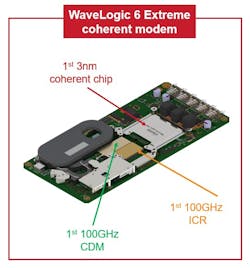Verizon’s new 1.6 Tbps trial with Ciena shows that the telco is keen to ensure its network can support the growing AI trend.
As one of the largest business service providers, the service provider recognizes that Generative AI, with its ability for predictive analytics, is becoming a critical component of digital transformation and future business growth in almost all industries.
During a recent trial in Boston, Verizon moved 1.6 Tbps of data in its live fiber network on a single-carrier wavelength using Ciena’s WaveLogic 6 Extreme (WL6e) coherent optical solution. This technology allows data to traverse Verizon’s fiber network farther and faster.
Adam Koeppe, Verizon's SVP of technology strategy and planning, said, “This continued advancement of our fiber network will further position us to be the provider of choice for AI workloads now and in the future.”
A flexible environment
A key takeaway of this trial is that it was conducted in a live metro network environment.
The trial took place over a 118 km Boston metro route that consisted of 10 hops and passed through nine reconfigurable optical add-drop multiplexers (ROADMs). This live metro network validated the performance of 1.6 Tbps using WL6e in what it said was “a flexible, dense ROADM environment.”
Ciena’s WL6e is a coherent transceiver using 3nm silicon to drive economic benefits for operators, including a 50% reduction in space and power per bit.
WL6e provides 1.6 Tbps, single-carrier wavelengths for metro ROADM deployments and maximizes network coverage for 800G connectivity.
Focus on sustainability
Another benefit that the trial showed was energy savings.
Verizon said upgrading this new equipment will result in higher reliability and significant energy savings in that portion of the fiber network.
According to Ciena estimates, the power efficiency of WL6e translates to an 86% reduction in emissions per terabit of capacity delivered (kgCO2e/Tb) compared to previously deployed technology.
For related articles, visit the Business Topic Center.
For more information on high-speed transmission systems and suppliers, visit the Lightwave Buyer’s Guide.
To stay abreast of fiber network deployments, subscribe to Lightwave’s Service Providers and Datacom/Data Center newsletters.

Sean Buckley
Sean is responsible for establishing and executing the editorial strategies of Lightwave and Broadband Technology Report across their websites, email newsletters, events, and other information products.


